Flavor
![]()
This article describes the term taste as a multimodal sensory impression during food intake. For the sense of taste, see Gustatory perception; for other meanings, see Taste.
Broadly speaking, taste (from Middle High German gesmac, 'scent, odor, stench, flavor', to smẹcken: 'to taste, to try; to feel, smell, scent; to perceive', from Old High German smẹcken, 'to feel taste', in contrast to smackën 'to give taste of oneself') is understood as a complex sensory impression during food intake, resulting from the multimodal interaction of the senses of smell and taste as well as touch, temperature and pain. The sensations related to a food in this sense as "taste" come about in many cases primarily through aromas perceived by the sense of smell and less through stimuli within the oral cavity. Therefore, impaired olfactory perception, as in the case of a cold, or a complete loss of the sense of smell (anosmia), results in a significantly impaired sensation of the tasted food.
The biological importance of taste lies in its role in locating food and in the examination of food that is introduced before it is swallowed and ingested. In interaction with other sensory modalities, the sensory impression of tasting is formed into a sensory image with which foods can now be compared and chosen, and thus then sought or avoided.
In humans, newborns already show preferences for certain taste qualities and prefer sweet and umami, while an innate aversion to bitter and sour can be observed. Natural substances that are toxic to the human organism taste mostly bitter and rarely sweet. Natural energy-rich foods have a particularly pleasant taste. And the preferred taste quality umami indicates animal or vegetable protein sources. Smell and taste sensations can reflexively stimulate the production of saliva and gastric juice even before or during eating or drinking. A taste that is perceived as unpleasant, on the other hand, can trigger a gag reflex or, in extreme cases, even lead to vomiting.
The gustatory and olfactory systems develop in the foetus as early as the second month of pregnancy; from the third month onwards, the unborn child perceives the taste of its amniotic fluid and is already preformed by this before birth with regard to later taste preferences.
The sensitivity for the perception of taste stimuli in humans is also genetically determined and varies from individual to individual. Researchers distinguish between normal, super and non-tasters. The ability to perceive taste generally decreases with age, and severe olfactory and gustatory impairments can lead to a loss of appetite.
The evaluation of a taste, which is influenced by enculturation and socialization, must be distinguished from the perception of taste. For example, the innate taste aversion to bitter substances is not retained absolutely throughout life in most cultures, as can be demonstrated by the consumption of coffee or beer. Hedonistic evaluation of taste influences the emergence of preferences and aversions, with individual experience playing an important role. What taste is perceived as pleasant "is, with a few exceptions, not a natural characteristic of food or dishes, but a cultural attribution to which eaters orientate themselves and which they largely adopt. (...) Taste, enjoyment and cuisine are the product of a long process of coordination, in which the kitchen practically implements the expectations of taste and enjoyment in each case".

The Sour LemonPainting by Julius Geertz (1867)
Physiology
→ Main article: gustatory perception
Currently, five taste qualities are generally scientifically recognized: sweet, sour, salty, bitter and umami. Separate taste receptors on the tongue have been identified for each of these. In 2005, additional special fat receptors were discovered for the first time in mice and rats. Older studies assumed that high-fat food would be recognized solely by the smell and texture of the food. In 2011, the existence of a fat receptor was also proven in humans. The existence of further taste qualities, such as metallic or alkaline, is still controversial.
The receptors of the sensory cells in the taste buds can only taste substances if they have dissolved or dispersed in contact with the saliva. It is now known that not every area of the tongue is sensitive to taste, but that every region of the tongue that is sensitive to taste does represent all gustatory qualities, albeit with small differences (in the past, it was erroneously assumed that there were regular taste zones on the tongue for the individual basic qualities). Sweetness is perceived somewhat more strongly in the region of the tip of the tongue and bitterness predominantly in the rear region of the tongue, towards the base of the tongue.
· Receptor distribution from Henry Gray's Anatomy of the Human Body
· 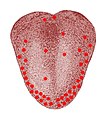
sweet
· 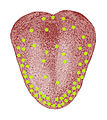
sour
· 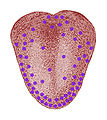
Salty
· 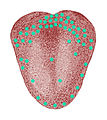
bitter
In fact, only a small part of the sensations perceived as taste (in a broader sense) is usually based on stimuli from the taste receptors. The often by far predominant part is caused by volatile aroma substances that irritate the olfactory epithelium in the uppermost nasal passage. When a food is chewed and moved back and forth in the mouth, the volatile components pass through the pharynx and the choana into the nasal cavity, where they can be registered by the olfactory cells. Olfactory and gustatory stimuli are picked up by sensory cells and their signals are transmitted by nerve fibres along separate routes to the brain, where they are distributed to different stations and compared with others. These differentiations are first combined in the thalamus of the diencephalon and then processed into more complex patterns in the cerebral cortex and formed into a (possibly conscious) sensory impression. Thus, as with any sensory perception, the overall impression of a taste is formed only in the brain, and if we can become aware of it, probably only in the end brain. The role that olfactory perception can play in the sensation commonly referred to as taste was demonstrated in an experiment in which blindfolded subjects drank a cup of hot water while coffee scent was simultaneously piped into the laboratory. All participants were convinced that they were drinking coffee beans. Whether this impression would also have been created if a cup of hot seawater had appealed to gustatory perception was not investigated.
Biochemical transduction can vary for taste stimuli; the pathways of signal transduction in sensory cells with taste receptors for sweet or bitter stimuli are more elaborate, so that signal formation and transmission takes just under a second, whereas sour and salty stimuli are detected more quickly. The signals formed by the secondary sensory cells in taste buds on the tongue and palate are picked up by nerve cell processes via synapses and transmitted as neuronal signals via nerve fibres of cranial nerves - taste fibres of the VIIth nerve (chordus facialis). Nervus facialis (Chorda tympani and Nervus petrosus major), the IX. Nervus glossopharyngeus and the X. Nervus vagus. Nervus vagus - to the Nucleus tractus solitarii of the Medulla oblongata in the central nervous system. From there, connections lead to the nucleus ventralis posteromedialis in the ventral thalamus, others to the hypothalamus and the amygdala. This is also where the transmission of signals from the sense of smell ends. This is where it is decided whether a taste quality is classified as pleasant or unpleasant.
Taste stimuli are only detected when their concentration exceeds the perception threshold. It is lowest with bitter substances. The intensity of the taste sensation decreases with the continuation of the same stimulus, habituation (adaptation) takes place and thus the ability to perceive the same taste stimulus with the same intensity or even at all decreases. Depending on the intensity of the taste sensation, this habituation effect lasts only minutes or even hours. With sour or salty stimuli, no complete adaptation takes place. However, regular salt consumption leads to a persistently lower sensitivity to this taste stimulus. This habituation is also discussed for sweet substances.
Taste perception is influenced by the temperature of the food. All taste stimuli can be perceived most strongly at temperatures between 22 and 32 °C. Sweet and bitter are only weakly tasted at a temperature of 0 °C. Hunger reduces the taste threshold for sugar and quinine, whereas the perception of the taste stimuli salty and sour is not changed by this.
Flavor spiciness
What is perceived as "spiciness" in food is actually not a gustatory stimulus at all, but a pain sensation on the tongue triggered by certain irritating substances, usually capsaicinoids. Chili contains the tasteless substance capsaicin, which, when eaten, biochemically stimulates the thermoreceptors of the trigeminal nerves in the mouth, which then send a pain signal to the brain. The same receptors react to heat stimuli above 43 °C, i.e. to food that is too hot, which "burns" the tongue. The brain reacts to the stimulus signal by triggering a pain sensation on the tongue and, to relieve the pain, releases endorphins that trigger pleasant feelings. There is also the term "pepper high" for this reaction. There is some debate as to whether this hormonal response triggers some psychological addiction to chili or other hot spices; however, this theory is controversial. With regular consumption of spicy foods, the sensitivity of the receptors also decreases, so that the spiciness is felt less strongly.
In 2003, researchers at the University ofCalifornia found that capsaicin on the tongue activates the hotness receptor TRPV1, which is otherwise blocked by a lipid. When this comes into contact with capsaicin, the bond is broken and pain is reported to the brain. The strength of the bond between TRPV1 and the lipid PIP2 varies from individual to individual and is above all genetically determined, so that the sensation of sharpness also varies from individual to individual.
Capsaicin, like the "burning" of the tongue, leads to an impairment of taste perception, but only for sweet, bitter and umami, while sour and salty continue to be tasted unchanged. Sugar, on the other hand, reduces the pungency of capsaicin.
Eucalyptus or menthol are also perceived as "hot" on the tongue, for example as an additive in sweets. However, the cold receptors on the tongue react to these substances.
See also: Gustatory acuity and trigeminal perception
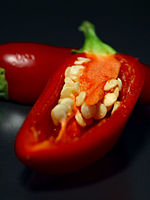
Red chilli pepper, cut open
Search within the encyclopedia